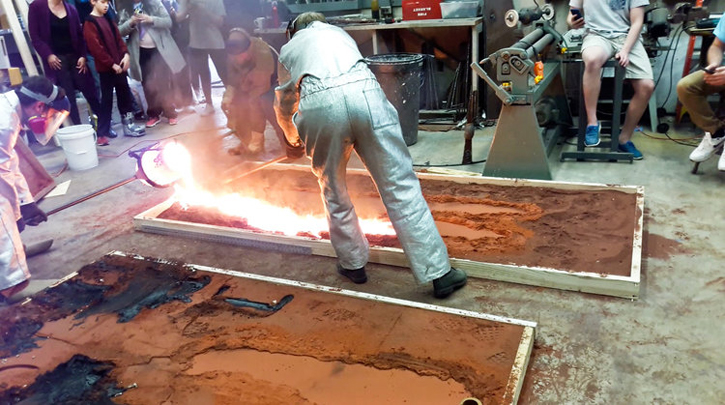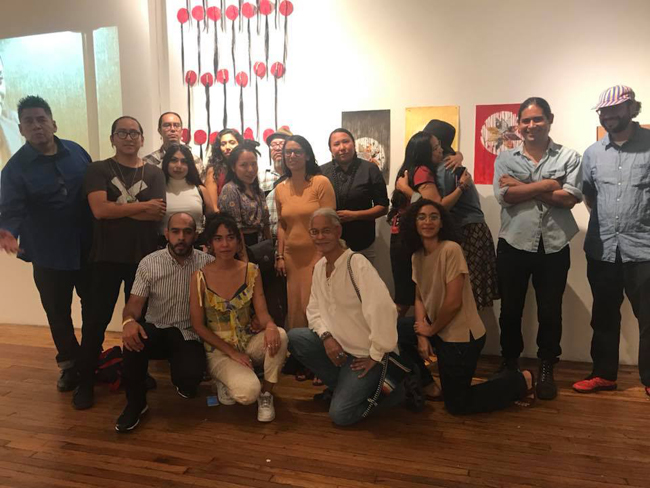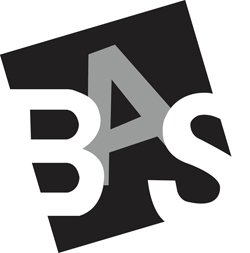In Conversation with Linda Cunningham
Randee Silv
March 2020
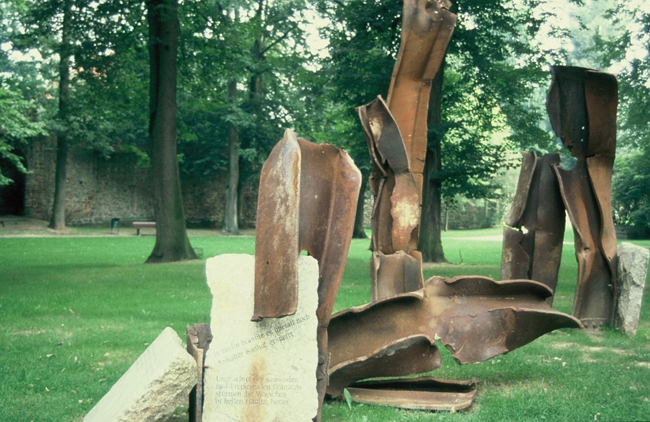 Covenant for Reconciliation, 1996, Stifts Ruine, a medieval cloister ruin used as open-air
Covenant for Reconciliation, 1996, Stifts Ruine, a medieval cloister ruin used as open-air
opera festival, Stadt Bad Hersfeld, Germany
“Compelling environmental concerns juxtaposed against industry, urban blight and the lost natural environment drive my work.”
“The ruptures of history and accumulated catastrophes have made the ruin a witness, not to the past but a paradigm of the present.”
“My work centers upon time, transience and contradictions.”
After having seen your bronze sculptures in the recent exhibition “Heavy Metal” at the Odetta Gallery in Chelsea, I’m curious about the process in which you turned salvaged military scraps into these very textural, organic forms. I watched the video “Bronze Pour at Franklin & Marshall College” on your website and was fascinated by the hot molten bronze being raked across the sand. Could you talk more about this technique of sand casting and what drew you to it?
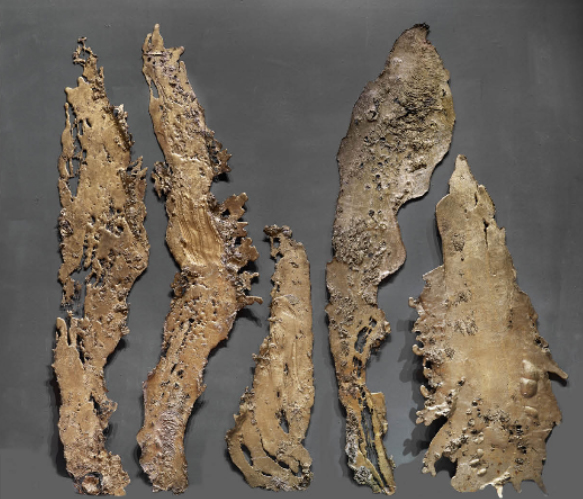 Heavy Metal, ODETTA Gallery, 2020
Heavy Metal, ODETTA Gallery, 2020
These bronze shapes were formed largely by the physical process of the pour, which forms this highly textured, bark-like surface as it runs out in the foundry sand form. The 2000 degree molten bronze cools rapidly, and so, in the video on my website, one sees me in disguise, clad in protective clothing with a garden hoe, swishing the hot bronze along in the mold so it would fill the form and record the movement of the hoe in its surface as it cools. I can manage to do what I want working in the small college foundry where I was formerly a professor.
I had done some bronze casting in grad school and had always loved Rodin’s Burghers, so with some interested students I developed the bronze casting facility. With the help of some experienced visiting artists, we began doing our own lost wax casting. I even visited Pietra Santa, a small town in Italy, known for its ancient casting skill, to learn some techniques. But I found the process of lost wax casting either excruciatingly labor intensive or extremely expensive. Sand casting has been mostly an industrial casting process; however some artists like Issac Witkin began experimenting with it in the 80s.
I had a head full of big ideas, and I had built one installation with the lost wax process of 5 semi-figurative images, including 3 parts that were 10 1/2ft high, that was exhibited on the Lincoln Center plaza of Fordham University, but I was in debt for 10 years after!
Then I tried building a low, flat sand-box filled with a special foundry sand and, finally after some experimentation, was able to pour large thin craggy shapes that I welded together into 11ft semi-figurative images I thought of as ”survivors”. I titled the piece War Memorial, and the 9 part installation was exhibited in the mall of the City University Grad Center when it stood on 42nd St. across from Bryant Park.
Michael Brenson wrote my first and only NY Times review of that work when it was first shown at Soho 20 Gallery in the late 80s, when it was still a ground floor space on Broome St.
 War Memorial, Tribeca traffic triangle, sponsored by the Lower Manhattan Cultural Council
War Memorial, Tribeca traffic triangle, sponsored by the Lower Manhattan Cultural Council
Yes, that’s a very powerful piece. All your installations in public spaces are. They’re so tactile, so provocative. One that I keep returning to is “Structural Transformations: An Environmental Memorial, 1990-91” that was on view at West Broadway & Chambers Street in Tribeca. The tension between the natural and industrial forms and the questions it raises can’t be ignored. I’m curious about the origins of those crater-like rocks and how you go about choosing the materials to be used.
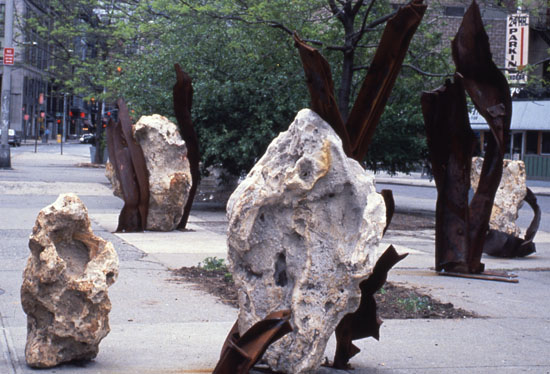 Structural Transformations: An Environmental Memorial, 1990-91
Structural Transformations: An Environmental Memorial, 1990-91
I was always bothered by the impact of concrete and the industrial built environment on the beauty and fragility of our amazing natural environment. I have always loved the qualities of stone and made 2 separate trips up the mountain in Cararra, Italy, where the marble for Michelangelo’s work was quarried. I also explored the abandoned caves on the Greek Island Paros, where the marble for the Parthenon was quarried, and made several small sculptures from loose marble pieces I carried out of the caves. Then I twisted some fragile bronze forms around the elegant white stone.
The massive stones with all of the cavities in the lower Manhattan installations are called Coquina and were formed at the bottom of the ocean from shells and sediment fused over millions of geologic years around harder stone elements like quartz. The shells are still visible in the surfaces and the composite stones can contain mollusks, trilobites, brachiopods. These stones were quarried in the Florida Keys area, and they always reminded me of the “viewing stones” elements in ancient Chinese gardens. Elizabeth Kolbert wrote in a New Yorker article a year or more ago that most of Southern Florida is built on such porous stone, so, with the higher tides and rising sea levels, the sea water comes right through the ground, quite different from the stone base of New York City. She says it will be impossible to save Miami Beach from the rising sea levels. I chose stones from 3 different formative processes, so the installation included colorful red lava and a grey limestone from the banks of a New Jersey river.
This installation was warmly received by the community and was twice approved by the community board for a total of a year long installation over the objections of the art committee at the time. There was a pre-school nearby and the children danced in circles around the stones and hid little ”treasures” in the cavities of the stones in that urban oasis.
At the time, the stones were installed on two different traffic triangles in Tribeca and later in a Snug Harbor, Staten island exhibition. Then, 2/3rds of the grouping were shown in Knoxville Tenn, and from that exhibition were purchased by an Atlanta collector. I still have the remaining 1/3 of the installation.
 Divisions, 1997-98, traffic triangle 1st Ave across from the United Nations, NYC
Divisions, 1997-98, traffic triangle 1st Ave across from the United Nations, NYC
I can see the similarity with “viewing stones”, a place for reflection, a synthesis of social & geological memory. You spent time in Berlin during the early 90s. What you witnessed living there must have greatly impacted the direction of your work. Can you also speak about the last public memorial you did across from the UN.
In 1994, I won a Fulbright Research Fellowship and spent a year in Berlin. It was just 4 years after the wall had fallen and the year that the Allied occupation formally ended. There was construction everywhere in the former East. Twisted steel beams much larger than the ones I had used to wrap the stones from our imperiled environment became metaphors raising questions about destruction, oppression, the future and blindness to the humanity of others. I incorporated granite sidewalk sections that they were tearing up while rebuilding the East engraved with quotations from the diaries of people who survived the bombing of Berlin. Other stones contain a prayer/poem in Hebrew and English, written in 1946 by Avraham Suskever. A quote from Audrey Lorde speaks individual choice, responsibility and silence, and another about hubris — Amerika’s mistaken belief in an obligation to export democracy at any cost. Two of these installations were purchased and are sited permanently in public space.
When I came back to the US, I got permission to install a much larger piece in the middle of 1st Avenue across from the UN protest plaza. A quotation from Emmanuel Levinas was translated into 6 official languages of the UN that equated acting humanely with being human.
The UN piece is the last big public memorial I built, but I am working on one now, very different in style. It is too soon to write about that, I think.
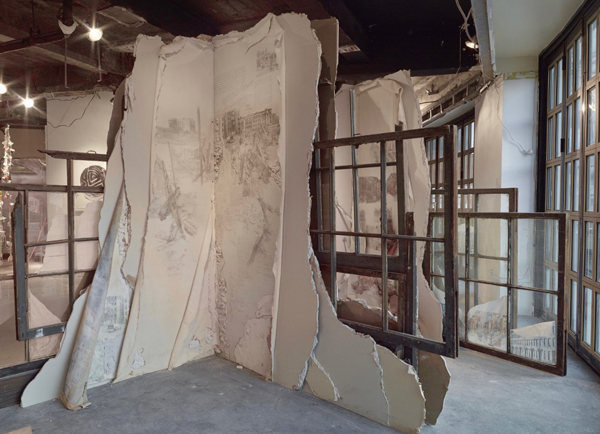 Paradise Lost/Regained? Utopia to Survival II, 2015
Paradise Lost/Regained? Utopia to Survival II, 2015
No Longer Empty Curatorial Lab, Grand Concourse, Bronx
The different ways you’ve integrated text into your work definitely opens up other levels of communication for viewers to engage with. I especially like how you build upon surfaces, how you identify and use edges, how you break apart boundaries, whether on paper, canvas or sections of broken dry-wall. The way you layer visual & textural information is very effective. How did photo transferring find its way into your vocabulary?
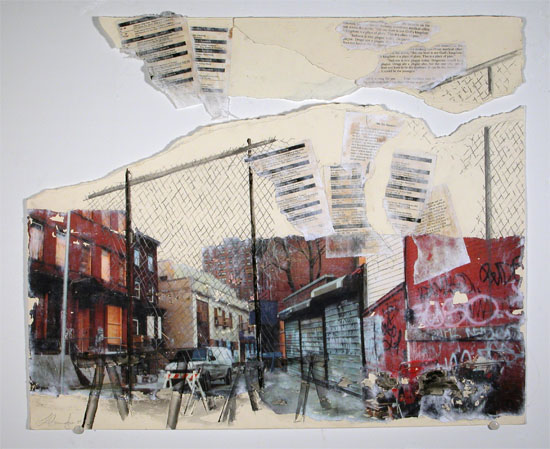 South Bronx Saga, 2005-2006
South Bronx Saga, 2005-2006
I went to a workshop, I think at the Lower East Side Printshop, and picked up a technique I liked, but only used as a teaching technique for several years. The students who were much too impatient to learn traditional etching could create instant art with a contemporary look with solvent and an etching press.
Then I found a need, and I used both an acrylic medium transfer technique, and then solvent transfers, to document the Bronx and the changing area surrounding my studio and home. The photo transfers were a crucial aspect of documenting the potential of the the South Bronx waterfront still dominated by trash and recycling. There are no jogging paths on the South Bronx waterfront.
 from Venice Series
from Venice Series
The photo transfers are part of my impulse to confirm the reality, to record, but with the added possibility to show with collage and drawing more complexity of circumstances, more than a photograph. For instance, in the Venice series, the photos show the canal water pooling on top of the sidewalks during a normal high tide, but I included images of the crumbling interiors and collaged golden bronze fragments, a reference to the gold mosaics, the gorgeous architectural treasure.
The bronze fragments are splatters left from pouring larger pieces and they are included with larger pours in my installation Whose Land? Whose God? with other treasurers, the photo transfers of ancient documents representing all 3 faiths that trace their heritage to Abraham.
All 3 faiths lived in harmony for 13 Centuries in Egypt and the Mediterranean areas. These were installed on broken dry-wall panels, symbolic barriers with actual remnants of the former East German border and the Berlin wall that were part of my installation in an alternative documenta exhibition. There is a small catalogue on this exhibition with an essay by Manon Slome, curator special projects of No Longer Empty.
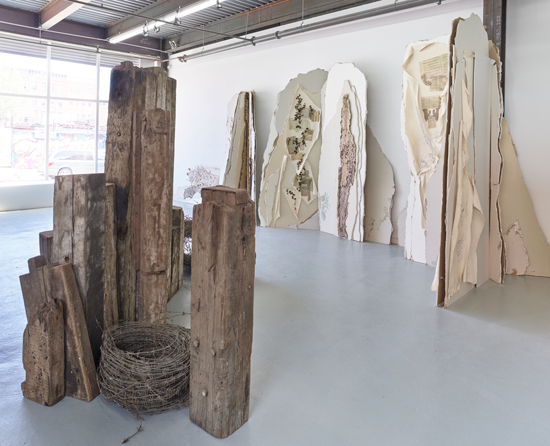 WHOSE LAND? WHOSE GOD?, 2017, ODETTA Gallery
WHOSE LAND? WHOSE GOD?, 2017, ODETTA Gallery
It’s fascinating that your choice of materials has allowed them to become voices in themselves. You had to have taken quite a few photographs before deciding on which to use for the 24 1/2 ft wide installation, South Bronx Waterfront Sagas (2017) that stretched across the lobby wall of the Bronx Museum. What went into the choices you made while putting this documentation together? Did you feel that the viewers got it? What were some of their responses? I’m sure much hasn’t changed since then. So, where does the future stand for the waterfront now?
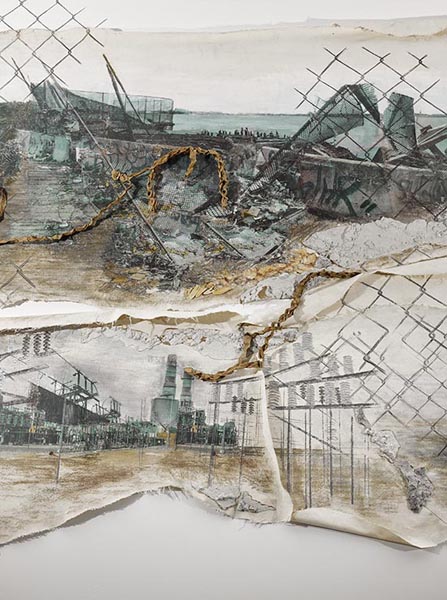 South Bronx Waterfront Sagas, 2017
South Bronx Waterfront Sagas, 2017
There are 2 places where it is possible to view the East River as it empties out into open ocean. One end of East 132nd Street is littered with a spectacularly ugly pile of broken cement and chain link fence barriers left in that condition since the 80s, when a Con Edison accident blew up the pier. Another is blocked by a sign from the Dept. of Sanitation forbidding entrance. There, one can see nearby a rotting pier and bridges spanning the river looking each way with views of Manhattan in the background. Late in the afternoon, this area is dominated by the trash trucks serving the entire Bronx, arriving to dump their refuse at the transfer station. The intersection of the Harlem River and the East River nearby offered the 3rd view from a neglected trash-ridden area at the foot of a bridge, where the view of Manhattan reveals a developed waterfront with benches and a skating/jogging walkway. Bloomberg’s waterfront development plans for Brooklyn, Queens and Manhattan, even Harlem, completely ignored the Bronx, even though resident lobbying groups had pressed for attention for 20 plus years.
I included collaged elements to invoke the rubble that exists still in the first site with the view of the open ocean and drew chainlink fence on the canvas that continued off the canvas onto the Bronx Museum wall.
I wanted to include metal shards, but the Bronx Museum would not allow that out of concern for the potential of visitors interacting with it, since a staircase went right next to the installation.
There was a cafe’ in the lobby, and when I bought my usual cappuccino, the barista told me every time what a positive response there was from the visitors. Sergio Bessa, then the director of programs, also told me just the other day that he found it a very successful installation. Holly Block had invited me to create the piece, but she was already very sick at that point, so I don’t know if she ever saw it. NPR was reporting on the changing circumstances in the South Bronx and broadcast an interview with me.
The Bette Midler’s NY Restoration Project has raised the funds to rebuild the pier that was once at the the end of East 132nd Street, but the project has been held up somewhere in city government. The developers planning luxury high-rises will build the waterfront promenade long denied Bronx residents.
Typical. I read that NYRP’s in-depth plan for environmental justice to revitalize the South Bronx was put together with neighborhood coalitions & activists. But it sounds like it might never be realized. Instead, developers & more gentrification have stepped in to take over. When I was at your studio, it was hard not to engage with these very intense paintings of whirlwind storms. What direction are you heading with these?
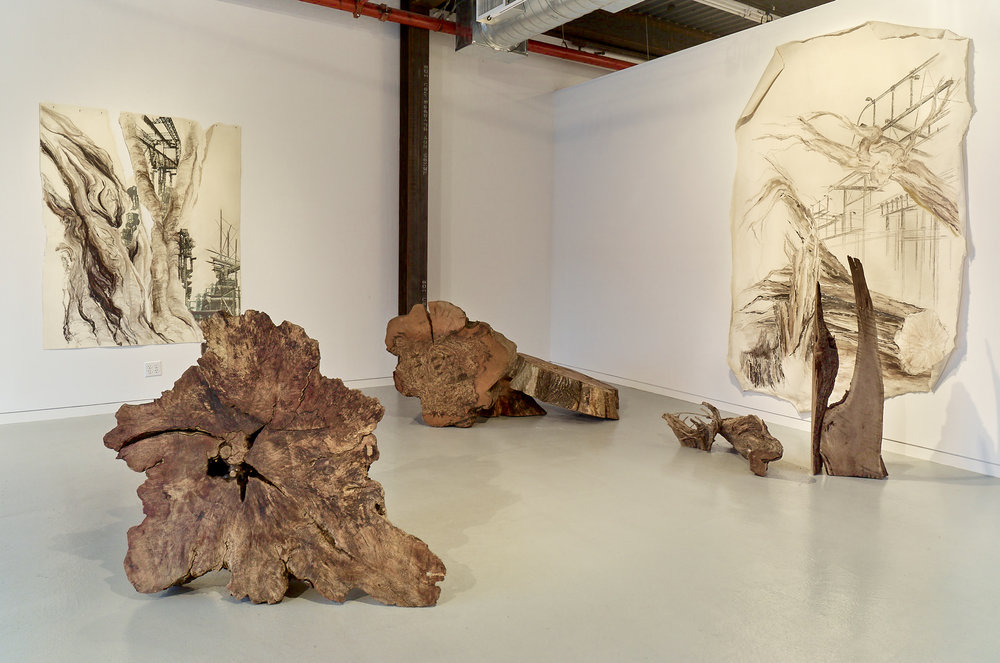 Edge of Change, 2015, ODETTA Gallery
Edge of Change, 2015, ODETTA Gallery
The scale of the storms pushed me to return to canvas, and after 3 tries, a satellite image set me off on a 10ft x 11ft piece that I think has many levels of associations, a little forbidding and somewhat beautiful, the first of a series. Two more, not quite so large, followed, and another is on the way.
I have been thinking about storms and their increasing intensity for a while since my sister lived through one in South Florida that changed direction so unexpectedly that she had to spend several hours in a closet behind a mattress while listening to the wind bash her young palm trees against her large glass windows. Then, the Elizabeth Kolbert’s article about the porous rock in South Florida that are like those in my installation. Then, Sandy hit NY and Woodlawn cemetery lost monumental 300 year old trees. I was able to rescue cross sections from a 4ft wide Linden tree and other trees that were part of my 2015 installation at ODETTA gallery in Bushwick. That installation was focused on the vulnerability of those beneficent, majestic old souls that are protecting us by removing the CO2 we mess up the environment with. I now have many others that have been waiting to be part of my next installation.
 Bronx ArtSpace, 305 E 140th St.
Bronx ArtSpace, 305 E 140th St.
Together with Mitsu Hadishi you opened the Bronx ArtSpace in 2008 with a focus on art that matters to the community. Besides featuring exhibitions, performances, workshops and concerts that center on a diversity of political & social issues, you offer an Artist Residency + Open Studios program, as well as an open call for emerging Bronx curators. Can you share some of your thoughts on how the Bronx ArtSpace has energized the creative environment of the neighborhood, and what are some of the upcoming events you have planned?
Although some other spaces are now opening up in the area, BronxArtSpace has been the only continuously open venue for contemporary art in the Mott Haven area of the South Bronx. However, for our community, we are a gathering place for an amazing range of programming, from a book reading group, to open mics to writing workshops and a location for groups communicating about significant issues like health, gentrification and immigration. This past weekend we hosted a screening of a documentary film about our courageous activist neighbor, Marco, who works with his family to run an excellent restaurant with authentic Oaxacan Mexican food, La Morada. There is now a bilingual theater neighbor, and they collaborate with BronxArtSpace to put on performances.
Upcoming exciting exhibitions feature both emerging and well known artists, including Fred Wilson, a Bronx born guy. The next is an exhibition dealing with memory and concepts of “home”, including 20 artists, most 1st generation of recent immigrant heritage. Then we will exhibit the photography of En Foco fellowship competition awardees.
We have gradually increased our outreach with social media as well as e-blasts, so we now draw a public from the wider Bronx and the other boroughs.

